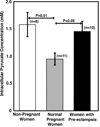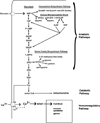Leukocyte pyruvate kinase expression is reduced in normal human pregnancy but not in pre-eclampsia
- PMID: 20560913
- PMCID: PMC3045787
- DOI: 10.1111/j.1600-0897.2010.00881.x
Leukocyte pyruvate kinase expression is reduced in normal human pregnancy but not in pre-eclampsia
Abstract
Problem: Emerging evidence suggests that metabolism influences immune cell signaling and immunoregulation. To examine the immunoregulatory role of glycolysis in pregnancy, we evaluated the properties of pyruvate kinase in leukocytes from non-pregnant women and those with normal pregnancy and pre-eclampsia.
Method of study: We evaluated pyruvate kinase expression in lymphocytes and neutrophils from non-pregnant, pregnant, and pre-eclampsia patients using fluorescence microscopy and flow cytometry. Leukocyte pyruvate kinase activity and pyruvate concentrations were also evaluated. To study pyruvate's effect on signaling, we labeled Jurkat T cells with Ca(2+) dyes and measured cell responses in the presence of agents influencing intracellular pyruvate.
Results: The expression of pyruvate kinase is reduced in lymphocytes and neutrophils from normal pregnant women in comparison with those of non-pregnant women and pre-eclampsia patients. Similarly, the activity of pyruvate kinase and the intracellular pyruvate concentration are reduced in leukocytes of normal pregnant women in comparison with non-pregnant women and women with pre-eclampsia. Using Jurkat cells as a model of leukocyte signaling, we have shown that perturbations of intracellular pyruvate influence Ca(2+) signals.
Conclusion: Normal pregnancy is characterized by reduced pyruvate kinase expression within lymphocytes and neutrophils. We speculate that reduced pyruvate kinase expression modifies immune cell responses due to reduced pyruvate concentrations.
Figures









Similar articles
-
Apoptosis signaling is altered in CD4⁺CD25⁺FoxP3⁺ T regulatory lymphocytes in pre-eclampsia.Int J Mol Sci. 2012;13(6):6548-6560. doi: 10.3390/ijms13066548. Epub 2012 May 29. Int J Mol Sci. 2012. PMID: 22837649 Free PMC article.
-
Kinetic properties of pyruvate kinase in human maternal leukocytes in fetal malnutrition.Pediatr Res. 1976 Jun;10(6):561-5. doi: 10.1203/00006450-197606000-00001. Pediatr Res. 1976. PMID: 1272633
-
Leukocyte subpopulation in ascites of women with pre-eclampsia.Am J Reprod Immunol. 2008 Oct;60(4):318-24. doi: 10.1111/j.1600-0897.2008.00629.x. Am J Reprod Immunol. 2008. PMID: 18754837
-
Oxidative stress in pre-eclampsia.Acta Obstet Gynecol Scand. 2001 Aug;80(8):719-25. doi: 10.1034/j.1600-0412.2001.080008719.x. Acta Obstet Gynecol Scand. 2001. PMID: 11531614
-
The concentrations of soluble HLA-G protein are elevated during mid-gestation and decreased in pre-eclampsia.Folia Histochem Cytobiol. 2012 Jul 5;50(2):286-91. doi: 10.5603/fhc.2012.0023. Folia Histochem Cytobiol. 2012. PMID: 22763960
Cited by
-
An enzymatic colorimetric assay for glucose-6-phosphate.Anal Biochem. 2011 Dec 15;419(2):266-70. doi: 10.1016/j.ab.2011.08.037. Epub 2011 Aug 27. Anal Biochem. 2011. PMID: 21925475 Free PMC article.
-
New insights into the relationship between viral infection and pregnancy complications.Am J Reprod Immunol. 2014 May;71(5):387-90. doi: 10.1111/aji.12243. Epub 2014 Apr 7. Am J Reprod Immunol. 2014. PMID: 24702790 Free PMC article.
-
Bioenergetic analysis of human peripheral blood mononuclear cells.Clin Exp Immunol. 2015 Oct;182(1):69-80. doi: 10.1111/cei.12662. Epub 2015 Jul 24. Clin Exp Immunol. 2015. PMID: 26032049 Free PMC article.
-
Cellular immune responses in the pathophysiology of preeclampsia.J Leukoc Biol. 2022 Jan;111(1):237-260. doi: 10.1002/JLB.5RU1120-787RR. Epub 2021 Apr 13. J Leukoc Biol. 2022. PMID: 33847419 Free PMC article. Review.
-
Staphylococcus aureus Responds to the Central Metabolite Pyruvate To Regulate Virulence.mBio. 2018 Jan 23;9(1):e02272-17. doi: 10.1128/mBio.02272-17. mBio. 2018. PMID: 29362239 Free PMC article.
References
-
- Brabin BJ. Epidemiology of infection in pregnancy. Rev Infect Dis. 1985;7:579–603. - PubMed
-
- Larsen B, Galask RP. Host-parasite interactions during pregnancy. Obstet Gynecol Survey. 1978;33:297–318. - PubMed
-
- Reinhardt MC. Effects of parasitic infections in pregnant women. Ciba Found Symp. 1979;77:149–170. - PubMed
-
- Cunningham FG, Leveno KJ, Hankins GDV, Whalley PJ. Respiratory insufficiency associated with pyelonephritis during pregnancy. Obstet Gynecol. 1984;63:121–125. - PubMed
Publication types
MeSH terms
Substances
Grants and funding
LinkOut - more resources
Full Text Sources
Medical
Research Materials
Miscellaneous

